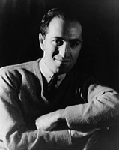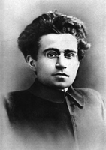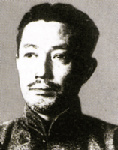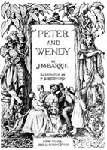
Welcome to the Public Domain
By Miriam Phillips
Jurisdictions with a 70 year period of post-mortem copyright protection will be welcoming into the public domain this year a wealth of works from authors, artists and musicians who died in 1937*. This selection was compiled by Miriam Phillips, a student of music at Cambridge University, UK, for the IPKat weblog.
Jean de Brunhoff (1899-1937)
From an early age, Jean de Brunhoff was inseparable from his books. However, he originally intended to become a professional artist, and studied painting at the Academie de la Grande Chaumière. After the birth of his sons, Brunhoff invented a bedtime story about a little elephant. His children took part in the creation of the storyline and Brunhoff himself illustrated the tale and turned it into a book. The original series traced six stages in the life of Babar the elephant: his birth, the loss of his mother, his journey to the city, his education, his return home, his marriage, his coronation, the birth of his children, and the development of his kingdom. After Brunhoff’s untimely death at the age of thirty-eight, his elder son Laurent expanded the series to the fifty-odd Babar books that exist today.
Sir James Matthew Barrie (1860-1937)
| A Gift of Copyright |
|---|
|
In 1929 J.M. Barrie donated his copyright in Peter Pan to the Great Ormond Street children’s hospital in London. The royalties from book sales, stage performances and the many film adaptations have provided a major source of income to the hospital ever since, helping it to become a centre of excellence in pediatric medicine. With the expiry of the copyright term in Europe approaching, the Hospital trustees came up with a creative solution. They ran a competition to select an author to write a Peter Pan sequel, with royalties from the new book to be split between the author and the hospital. The new work, Peter Pan in Scarlet, by Geraldine McCaughrean, was published in 2006 to critical acclaim. The film and TV rights were sold shortly afterwards. |
George Gershwin (1898-1937)

Photo by Carl Van Vechten
Born Jacob Gershowitz, to a family of poor Jewish immigrants, George Gershwin was to become one of America’s leading composers. He taught himself to play by ear until he began formal tuition at the age of twelve. Within a few years, Gershwin had published his first song and was already attracting the attention of Broadway composers before being propelled to fame by Rhapsody in Blue, written in the early 1920s. Subsequently, he began to collaborate with his brother Ira, a lyricist, to write Broadway musicals, their first being Lady Be Good (1924). Gershwin also continued to write for the classical orchestra and for piano solo, achieving international acclaim in both ‘traditional’ circles and modern society.

Antonio Gramsci (1891-1937)
Antonio Gramsci had a difficult childhood. His father was unable to get a job after a stint in prison charged with maladministration. The family of nine struggled with financial problems, and the young Gramsci suffered from ill health which left him a hunchback. After winning a scholarship to study at Turin University, he became involved with the socialist movement. When the Italian Communist Party was founded in 1921, Gramsci was elected as a member of the central committee and, after a year in Moscow, returned as Party leader. He was jailed in 1926 for opposing Mussolini, and forbidden to write for three years. From 1929, Gramsci kept prison notebooks. When he died in prison at the age of forty-six, he had written thirty-three books. Tatiana, his sister-in-law, managed to smuggle these books out of prison and arranged for their publication in Moscow.
Ahmad Javad (1892-1937)
Ahmad Javad Akhundzade is best known for writing the words of the Azerbaijani national anthem, as well as a number of poems. In 1918 he became a member of Azerbaijan’s Musavat Party and later became a member of the central committee. He was also the leader of the Musazat Literature Union. The Soviet regime was always suspicious of him, and had him arrested in the early 1920s on ‘counter-revolutionary’ charges. Several years later, accused of encouraging nationalism and independence, he was arrested again and executed in October 1937.
Ikki Kita (1883-1937)

In his student days, Kita was attracted to the socialist cause and met with many influential figures in his native Japan. After the outbreak of the Chinese Revolution in 1911, Kita traveled to China to help oust the Qing dynasty from power. But by the time he returned to Tokyo eight years later, he had grown disillusioned. A founding member of Yuzonsha, an ultranationalist organization, Kita replaced his socialist philosophy with a pro-fascist one. While promoting national unity, Kita also believed that the way forward was a military coup d’etat, followed by a totalitarian Imperial regime which would suspend the constitution and remove corruption. Part of his ‘reorganization’ plan involved limits on individual wealth, and land reforms for the farmers. Kita’s writings became influential in pre-war Japan, and contain a unique blend of fascism, Marxism, agrarianism and militarism.
Karol Szymanowski (1882-1937)
The composer and pianist Karol Szymanowski was born into a wealthy Polish family. After studying music privately with his father, Szymanowski attended first the Gustav Neuhaus’ Elizavetgrad School of Music, then the State Conservatory at Warsaw. In 1926 Szymanowski became director of the latter institution, but retired four years later. Opportunities for music making under the Russian occupation were limited, and Szymanowski found much inspiration on his extensive travels through Europe, Amercia, North Africa and the Middle East. Despite this, the composer always retained a deep love for Polish folk music – an attachment which shows through clearly in his compositions. In addition to his many musical works, Szymanowski also produced a collection of poetry and a novel.
* Note. The term of copyright protection can be affected by other rules in the various countries. In some countries, for example, the term has been temporarily prolonged because works could not be exploited during wartime. The term will also be longer for works co-authored with another person whose term of protection has not yet expired. It is advisable always to check carefully the status of a work in light of the applicable national legislation before using it without authorization.
The WIPO Magazine is intended to help broaden public understanding of intellectual property and of WIPO’s work, and is not an official document of WIPO. The designations employed and the presentation of material throughout this publication do not imply the expression of any opinion whatsoever on the part of WIPO concerning the legal status of any country, territory or area or of its authorities, or concerning the delimitation of its frontiers or boundaries. This publication is not intended to reflect the views of the Member States or the WIPO Secretariat. The mention of specific companies or products of manufacturers does not imply that they are endorsed or recommended by WIPO in preference to others of a similar nature that are not mentioned.
